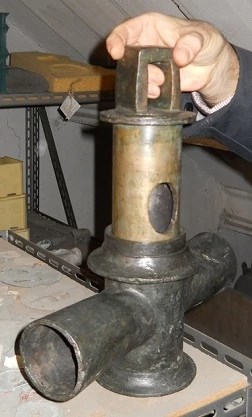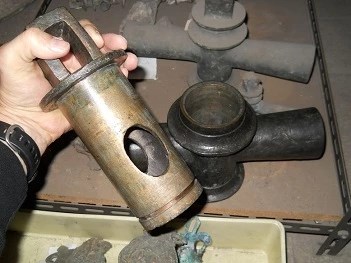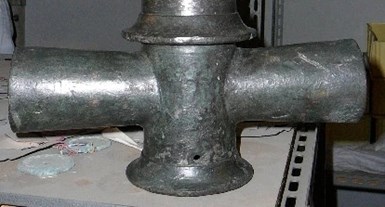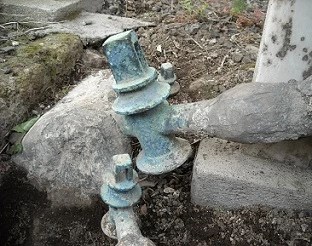Several technological accomplishments by the Roman engineers made water available to the urban centers. Among these accomplishments were aqueduct design, surveying, tunneling construction, lead piping, inverted siphons, lead storage tanks and valves. Even though the water was plentiful, the Roman water commissioners implemented controls to limit illegal taps and control the flow to users.
The Wright Paleohydrological Institute (WPI) has been studying water use in the ancient city of Pompeii. This study has included the use of water valves to control the flow of water to the houses and businesses within the city.
Ancient or Modern Design?
The Romans used lead piping to distribute water to cities and towns throughout the Roman Empire. The use of lead piping was prevalent in the 1st century B.C. and for the next several centuries. The use of valves to control the flow of water in these pipeline systems was also Empire wide. This universal use of valves and piping required a level of standardization that is familiar to modern engineers.

Figure 1. Photo credit, all: Ministry for Better Cultural Activities — Superintendent for Archaeological Good of Naples and Pompeii
The design of ancient Roman water valves is remarkably similar to our modern plug valve design. Typical Pompeian water valves are shown in the figures. The valve bodies were made of bronze with a typical inline configuration as shown in Figure 1, although the Romans also manufactured angle valves with very similar construction. The valve body has a cylindrical chamber into which the cylindrical plug was inserted, as shown in Figure 2.

Figure 2.
The valve body was welded into the lead pipe on each end with the valve side of the union being inserted into the lead pipe sleeve. Molten lead solder was then used to weld the insert on each side of the valve. Although the Romans had knowledge of threaded pipe, no known threaded joints were used on pipe or valve unions. As shown in Figure 1 and Figure 2, the pipe diameter of the valve body tapered into the plug chamber, which would have resulted in increasing water velocity and a finer adjustment of water flow.
The valve plug insert was also made of bronze and was a hollow cylindrical insert with an oval hole on each side of the cylinder to allow the passage of water. As with modern valves, the plug insert was rotated within the valve body to either control the flow or provide shutoff.

Figure 3.
The plug insert also had a slot that was molded or cut into the external surface of the cylinder base, as shown in Figure 3.
The valve body had a small hallow hole (see Figure 4) near the body base that matched up with the hallow slot encircling the plug insert. After the plug was inserted into the valve body, a punch was hammered to produce a bulge on the interior surface on the body that allowed rotation of the plug insert, but prevented its removal from the top (Fassitelli, 1972). This design also prevented the plug insert from popping out of the valve body under water pressure variations.

Figure 4.
What is remarkable is that these 2,000-year-old valves are quite similar to water valves that can be purchased at local hardware stores today!
Materials Science
Much of what we know about Roman water engineering has been handed down to us in two remarkable books by Sextus Julius Frontinus called De Aquis Urbin Romae, or Water Supply of the City of Rome, which were written about 97 A.D. Frontinus was the Curator Aquarium, or water commissioner for Rome. In the De Aquis, Frontinus addresses the standardization of 15 pipe sizes by diameter, circumference and flow capacity. These pipe standards were used throughout the Roman Empire, and the standards also applied to valves.
Independent studies have shown that, indeed, valves and pipe manufactured by the Romans were alike in relative dimensions; they were standardized. It turns out that De Aquis was the forerunner of our ASTM and ASA standards.
The valves were also very much alike in material composition. Copper, lead and tin were very important materials in the Roman metallurgical industry. They provided resistance to corrosion and friction and the ductility required for easy manufacture (Fassitelli, 1972).
Based on metallurgical studies, the materials used for the casting of Roman valves were:
- 73% copper
- 19% lead
- 8% tin
Several ancient valves that have been tested have results that are very consistent with respect to the materials and percentages used in their manufacture. The Romans had a standard metal alloy mix for valves and they were manufactured with a high standard of quality control. The metal composition shown above for the ancient valves corresponds very closely to the modern ASTM B67 standard for journal bearings used in automobiles and railroad cars.
Low Water Pressures
The Roman water valve design fit well with the water pressure design of the lead piping. The lead piping was designed for low water pressure applications (with a few rare exceptions where lead piping was used as an inverted siphon). WPI has studied the water distribution system in Pompeii. Water was delivered through a system of water towers that maintained water pressures at approximately 8-9 psi (18-20 feet). Although this water pressure is much less than what we design for today, it was sufficient for water distribution in Roman cities and towns.
The water flow in the distribution system was controlled by constricting the pipe (a calix) or valves. These were key to the conservation and proper use of the supply.
Pompeii House Valves
In Pompeii, water was delivered through the lead piping to public fountains, public baths, businesses and individual private houses. Having water delivered to a house was considered a luxury and was an indication of the social status of the house owners. Only a small percentage of the private houses in Pompeii received water into the house. In homes, the water was on full display by the use of distinctive and artistic water features.

Figure 5.
The valves that controlled the flow to these locations were fabricated onto a lead pipe manifold. The entire assembly, shown in Figure 5, was placed at the foot of the water feature. This is a remarkable example of the know-how of the engineers of that era. One can marvel that the Roman valve design from more than 2,000 years ago is strikingly similar to our modern design.
Reference
Fassitelli, E. Pipe and Valves of Ancient Rome, Petrolieri d’Italia, Milan Italy, 1972.
Photographs shown with permission of the Ministry for Better Cultural Activities – Superintendent for Archaeological good of Naples and Pompeii
Wayne F. Lorenz is president of Wright Water Engineers, Inc. a civil engineering firm based in Denver, Colorado. He is also director of Roman Aqueduct Studies at the Wright Paleohydrological Institute, a nonprofit research firm that studies how ancient peoples used water.
RELATED CONTENT
-
3D Printed Inconel Sleeve Protects Critical Valves from Thermal Shock
Valve manufacturer Velan has developed a double-walled sleeve using lattices as thermal insulation to protect critical severe service valves from thermal shock and stress.
-
What's the Chatter About Check Valves?
Sizing and selecting the right check valve type can avoid any problems before they start.
-
Industry Profile: Stephane Meunier
What inspired you to pursue a career in the world of valves and actuators? It was a matter of being at the right place and at the right time!








 Unloading large gate valve.jpg;maxWidth=214)


